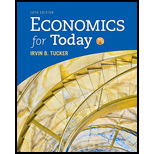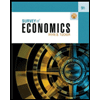
Economics For Today
10th Edition
ISBN: 9781337613040
Author: Tucker
Publisher: Cengage Learning
expand_more
expand_more
format_list_bulleted
Concept explainers
Question
Chapter 2, Problem 6SQP
(a)
To determine
The
(b)
To determine
The inefficiency point.
(c)
To determine
The law of increasing
(d)
To determine
Shift in the production possibility curve.
Expert Solution & Answer
Want to see the full answer?
Check out a sample textbook solution
Students have asked these similar questions
not use ai plesea
Question 20
Economic value added is used to
O measure the company's profits
None of the above
measure the company's sales
measure the company's expenses
D Question 21
Please asap with explanation
Chapter 2 Solutions
Economics For Today
Ch. 2.6 - Prob. 1YTECh. 2.7 - Prob. 1GECh. 2 - Prob. 1SQPCh. 2 - Prob. 2SQPCh. 2 - Prob. 3SQPCh. 2 - Prob. 4SQPCh. 2 - Prob. 5SQPCh. 2 - Prob. 6SQPCh. 2 - Prob. 7SQPCh. 2 - Prob. 8SQP
Ch. 2 - Prob. 9SQPCh. 2 - Prob. 10SQPCh. 2 - Prob. 11SQPCh. 2 - Prob. 12SQPCh. 2 - Prob. 1SQCh. 2 - Prob. 2SQCh. 2 - Prob. 3SQCh. 2 - Prob. 4SQCh. 2 - Prob. 5SQCh. 2 - Prob. 6SQCh. 2 - Prob. 7SQCh. 2 - Prob. 8SQCh. 2 - Prob. 9SQCh. 2 - Prob. 10SQCh. 2 - Prob. 11SQCh. 2 - Prob. 12SQCh. 2 - Prob. 13SQCh. 2 - Prob. 14SQCh. 2 - Prob. 15SQCh. 2 - Prob. 16SQCh. 2 - Prob. 17SQCh. 2 - Prob. 18SQCh. 2 - Prob. 19SQCh. 2 - Prob. 20SQ
Knowledge Booster
Learn more about
Need a deep-dive on the concept behind this application? Look no further. Learn more about this topic, economics and related others by exploring similar questions and additional content below.Similar questions
- Please give with explanationarrow_forwardnot use ai pleasearrow_forwardand u (C1, C2) = 1/2 = f) Derive analytically and show graphically the solution under other util- ity functions such as u (C1, C2) ac₁+bc2 where a, b > 0, u (C1, C2) = ac₁+bc1/2 acbc2 (assume that the agent is sufficiently rich to avoid the corner solution). What of these utility functions reflects best your own preferences (or indicate other utility function that represent your pref- erences).arrow_forward
- not use aiarrow_forwardExplain if any states are not a “friendly” place for tax preparers, payday lenders, title pawn lenders, and “credit approved” used car dealers to operate in and what they have done, regulation-wise.arrow_forwardExplain the regulation or lack of regulation of payday lenders, title pawn lenders, and “credit-approved” used car dealers in Alabama.arrow_forward
- Explain why people should avoid the business model of payday lenders, title pawn lenders, and “credit approved” used car dealers.arrow_forwardExplain why people fall prey to payday lenders, title pawn lenders, and “credit-approved” used car dealers.arrow_forwardPlease answer the following.arrow_forward
arrow_back_ios
SEE MORE QUESTIONS
arrow_forward_ios
Recommended textbooks for you




 Survey of Economics (MindTap Course List)EconomicsISBN:9781305260948Author:Irvin B. TuckerPublisher:Cengage Learning
Survey of Economics (MindTap Course List)EconomicsISBN:9781305260948Author:Irvin B. TuckerPublisher:Cengage Learning Economics (MindTap Course List)EconomicsISBN:9781337617383Author:Roger A. ArnoldPublisher:Cengage Learning
Economics (MindTap Course List)EconomicsISBN:9781337617383Author:Roger A. ArnoldPublisher:Cengage Learning





Survey of Economics (MindTap Course List)
Economics
ISBN:9781305260948
Author:Irvin B. Tucker
Publisher:Cengage Learning

Economics (MindTap Course List)
Economics
ISBN:9781337617383
Author:Roger A. Arnold
Publisher:Cengage Learning